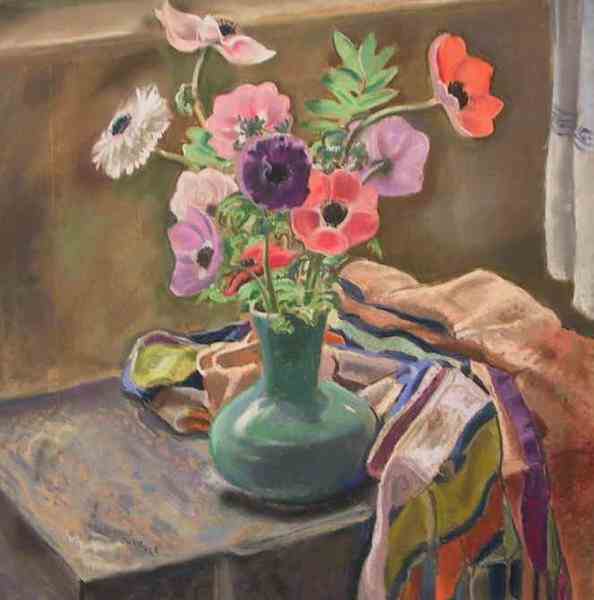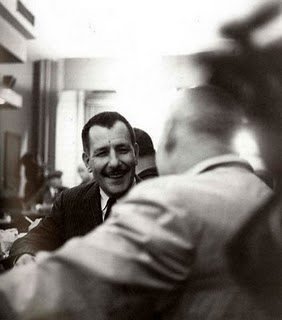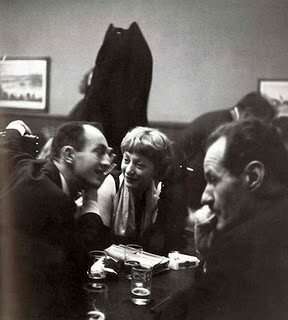the reluctant collector
CAROL R. SCOTT
___________________
Carol
R. Scott was a freelance writer and communication consultant.
Now, in her retirement, she teaches English to adult immigrants
from Africa, Asia, Central and South America and the Middle
East.
TREASURE
IN THE ATTIC
“I’d
like to introduce you to Carol Scott. She’s a collector,”
Franklin Robinson, then President of the Rhode Island School
of Design Museum, said as he introduced me to a board member
using that designation. The occasion was a retrospective --
“Prints Between The Wars” that included 29 pastels,
paintings and drawings from the estate of American artist
Mabel Lisle Ducasse (1895-1976) of which I owned over 500.
I
had never thought of myself as a collector, although I’ve
worn many hats: free-lance writer, consultant, ad copy person,
executive and sometimes chief in charge of PR, I’m not
an artist; art simply gives me pleasure.
 I
hadn’t set out to be a collector. I am neither particularly
acquisitive nor wealthy enough to afford an important collection.
But somehow, I inherited two major collections: the paintings
and drawings of Mabel Ducasse and the historic photographs
of Arthur Swoger. I never met Mabel Ducasse and only briefly
got to know, before his death, Arthur Swoger.
I
hadn’t set out to be a collector. I am neither particularly
acquisitive nor wealthy enough to afford an important collection.
But somehow, I inherited two major collections: the paintings
and drawings of Mabel Ducasse and the historic photographs
of Arthur Swoger. I never met Mabel Ducasse and only briefly
got to know, before his death, Arthur Swoger.
My
passion for art, my affinity for artists, my sense of aesthetics
and confidence in a good eye is a result of my upbringing.
I should really say more chutzpah than confidence (everyone
else said I was crazy). 
My
family home featured original paintings, sculptures and beautiful
furniture such as early Eames chairs. My parents also personally
cared for artists. Ernst Lichtblau (1883-1963), a gnome of
a man at 5-feet tall, became an ongoing guest in our first
home.
Lichtblau
arrived in the US after fleeing Austria and the Germans in
the 40s and would later be remembered as founder of the Department
of Interior Architecture at the Rhode Island School of Design.
He brought both a European/Viennese and mid-century sensibility
to his design, recommended and selected fine furniture, exquisite
fabrics for sofas and cushions, proscribing their placement
according to colour, shape and style. We lived with built-in
shelves and drawers inspired by geometrical art of Mondrian
with flat matte-like squares of colour, cork floors, an abundance
of wood, chrome ,paintings and prints by local artists. An
appreciation for art became second nature.
And at the age of 20, when I left my husband, with babe in
arms, a crib, a minimum wage job at a local art gallery, and
a “ family” of artist friends, I knew that furnitureless
as I was, my first apartment adornments would be paintings
and drawings .
I
started collecting paintings and sculpture some 50 years ago.
My first purchase, by an artist/sculptor who would later become
my lover, was a beautiful drawing of entwined lovers. Priced
$75 and paid in increments of $5 a month, was a big investment
at the time but I just couldn’t resist.
Over
the years, I continued collecting – very slowly indeed.
I attended exhibitions, wrangled invitations to salons and
often posed for paintings and sculpture. I soon had a modest
collection of contemporary New England art that fit nicely
into the apartment and would grow larger as I moved into larger
spaces. Because
artists were my friends, I was often portrayed in their work.
Quick pastel portrait sketches and bas-reliefs of my face
in many forms, bronze torsos that resembled miniature versions
of wooden sculptures found on the prow of ancient ships are
only some examples. Later I added portraits of others, landscapes
and sculptures.
So
how did such a modest assemblage evolve into an overabundance
of art now spilling out of the attic and bursting closets
at their seams and leaving not an inch of wall space for the
calendar? The answer is an adventure story that includes murder,
mayhem and a rough patch of disengagement and depression.
My
thirties were marked by the deaths of friends, young and old.
One friend killed himself in anger, found hanging by his wife
after an argument. Another at 35 was done in by diabetes and
drink. Though warned, she died a year after she fell into
a coma. A cousin swerved to avoid a rabbit – was tossed
from his car – died instantly as did the rabbit. A 19-
year-old set herself on fire; no one really knows why. There
were more; twelve in all, so many who would be “un-remembered.”
The
last was Norma Rainone, a neighbour and friend, who was shot
in a robbery outside her back door. During those three sad
years before she was murdered, I ran into her occasionally.
When I did she would talk about boxes of a friend's paintings
she had stored in her attic. They would be thrown out, she
explained, could I help her mount a show or do some PR? Overwhelmed,
I said no.
After
her death, repenting my harshness, I spent days with Edward,
her lover, emptying her fridge, listening to CDs of her reading
the poetry of a university acquaintance, sending remembrances
to people she loved -- a process of mourning that felt comforting
and complete. We worked together, packing his things for his
escape to an island/country named Saba. Finally we came to
the boxes.
 We
were stunned as we went through each box and discovered the
life’s work of one artist from childhood to death. There
were six boxes in all. We thought we might find a few dozen
paintings Shocked, we found 500 pastels, oils, etchings and
fine pastels carefully inserted between the pages of old,
extra-large sized Life magazines.
We
were stunned as we went through each box and discovered the
life’s work of one artist from childhood to death. There
were six boxes in all. We thought we might find a few dozen
paintings Shocked, we found 500 pastels, oils, etchings and
fine pastels carefully inserted between the pages of old,
extra-large sized Life magazines.
The
quality was staggering. Hopperesque women from the 1920s wearing
silk stockings and cloches, blowing smoke rings in the air.
A solitary woman on a bench waiting for a train perhaps --
the viewer doesn’t know. A turbaned beauty applying
makeup with pastel so thick one would swear it truly resembled
lipstick. Nature studies of flowers, cicadas, worms, butterflies
and moths magnified 100 times which all reminded us of the
work of Georgia O’Keeffe
There
were letters, articles and documents confirming that Mabel
was a graduate of the Art Student’s League and Pratt
Institute in New York and from the University of Washington.
We learned that she was the first person in the United States
to receive a Master of Fine Art. 
We
found clippings that attested to her brilliance and exhaustive
knowledge of art. She had been the art critic columnist for
what was then The Providence Journal, Rhode Island’s
largest news outlet in the early 1900s.
What
is your plan, I asked Edward? Donate it to the Providence
Art Club, he said. They had shown an interest. No, I objected,
fearing the collection would be buried in this somewhat exclusive
club’s cellar. Edward agreed and passed the collection
onto me. I became re-engaged with life. Though Ducasse was
unknown to me, I knew that unlike my lost friends this would
be one person whose work and life would not be forgotten.
I
photographed the work and traveled it around. The RISD museum
(Rhode Island School of Design) booked a show two years ahead.
The Vose Gallery of Boston was impressed and encouraging,
but pastels, I learned, were not its thing because pastel
drawings are more difficult to maintain and sell. The Newport
Art Museum and Rotch Duff Jones House and Garden Museum and
several private galleries planned shows down the line.
 I plunged, feet first, into researching and learned that Mabel
moved twice to Rhode Island (doomed to live in Rhode Island,
she said) as she followed first one (a philanderer) then another
husband (a philosophy professor) to the State. Brown University
-- where her husband taught and the institution to whom she
had bequeathed her possessions, said her art had no value
– accepted the house she designed, her easel, pastels
and furniture but made it clear they would not keep her art.
I plunged, feet first, into researching and learned that Mabel
moved twice to Rhode Island (doomed to live in Rhode Island,
she said) as she followed first one (a philanderer) then another
husband (a philosophy professor) to the State. Brown University
-- where her husband taught and the institution to whom she
had bequeathed her possessions, said her art had no value
– accepted the house she designed, her easel, pastels
and furniture but made it clear they would not keep her art.
It
took years of persistence to see Mabel’s art recognized
but now there are 1,700 entries when one googles her name.
Her work hangs in the homes of my friends, in several museums
and galleries across the country. Her work, so far, is surviving
the test of time.
For
the most part, the Ducasse work has been returned to Seattle
and is frequently exhibited at the Martin–Zambito Fine
Art gallery close to where she lived and went to school. There,
David Martin and Dominic Zambito, gallery owners and collectors
of collections write about her and other lesser known artists
and their historical place in northwestern regional art. But
not all of her work is there: the lipstick lady is in the
RISD museum; a portrait of her friend Anne Louise Strong can
be found at the Florida International University as part of
the Wolfsonian Collection; breathtaking still life works can
be found at the Denver Museum and in the homes of many friends
and also strangers.
I’ve
kept some of her work. One of my favourites is a WWI patriotic
rendering of a mother rocking her child next to a gold-starred
window while waiting for a soldier/husband who will never
come. Two others speak to my love of the outdoors and the
unusual: one features a spectacular oversized caterpillar
making its way across two pompom blossoms; the other an equally
large and rather monstrous worm resting on tomato plant leaf.
Mabel
Ducasse was not the only collection I came upon under odd
circumstance. Decades later, the photographer Arthur Swoger
and his writer wife, Rachel, were living down the hill from
my 1724 house in the small town of East Greenwich. I met them
briefly through friends before Arthur died.

He
was handsome and, most often, sweet – but ill and feeble
at that time; she was vigorous, outspoken, wryly funny and
very impatient.

In
his 80s, Arthur became cranky, demanding and ever more frequently
in and out of hospitals until a discouraged Rachel finally
arranged to put him in a home. As Arthur raged on in a senior’s
citizen home, Rachel and I connected. My dog, Mariah and her
cat brought us together as more than neighbours. It started
when my dog lunged toward her cat. The leash held, Rachel
forgave me and we became Scrabble friends.
 And
that’s how I became acquainted with Arthur Swoger’s
large and magnificent photographs of animals, insects, flowers
and mushrooms, much of it commissioned by National Geographic.
The Swogers had made their home in Greenwich Village, the
heart of where the arts and artists thrived from the 40s through
the 80s. Fun-loving, bohemian people, often visiting the Cedar
Tavern (affectionately nicknamed the Bar), and known as the
“living room” by some of the greatest abstract
expressionists, writers and critics of their time, Arthur
had taken hundreds of un-posed photos of every one.
And
that’s how I became acquainted with Arthur Swoger’s
large and magnificent photographs of animals, insects, flowers
and mushrooms, much of it commissioned by National Geographic.
The Swogers had made their home in Greenwich Village, the
heart of where the arts and artists thrived from the 40s through
the 80s. Fun-loving, bohemian people, often visiting the Cedar
Tavern (affectionately nicknamed the Bar), and known as the
“living room” by some of the greatest abstract
expressionists, writers and critics of their time, Arthur
had taken hundreds of un-posed photos of every one.
Notable
subjects included Jackson Pollack, Willem and Elaine DeKooning,
Salvador Dali, Franz Kline, Philip Guston, Harold Rosenberg
and many more. Scenes ranged from a rather drunk Franz Kline
necking at the bar with an anonymous beauty, to critics arguing
philosophy (or so it seemed) and quiet dignified views of
tableside chats between the deKoonings, Frank O’Hara,
Mercedes Matter etc. Rachel shared the story of her years
of anger, all the years she supported them so that Arthur
could pursue his art. An artist herself, she had little time
to follow her heart, always held a 9-5 to pay the family keep
and was left with many painful memories she preferred to put
aside. While walking Mariah every day, I’d find boxes
of Arthur’s notebooks, photos, negatives and sketches
put out for trash. I waited a month before I told Rachel that
I had picked up every box, examined his work carefully and
was convinced I could sell it and help her get out of debt.

What
I didn’t sell of Arthur’s work stays mostly in
my closet, the negatives of mid-century artistic celebrities
in waiting. The slides of mushrooms and other nature studies
have not yet found a home. One, a close-up of coupling grasshoppers,
hangs in my home next to my first purchase - the entwined
lovers - above my bed. I'm hopeful that one day an appropriate
library, museum or other interested institution will request
a donation.
Works
by Arthur’s wife Rachel, who did not paint until she
retired, have been added to my original collection. An elegant
and colourful watercolour of hers sits over the mantel and
a nude self-portrait called Valentine hangs over a dresser.
And
of course, my walls and surfaces remain covered with art.
As I’ve aged and traveled, I’ve added small pieces
to the existing collection: a coffee root sculpture purchased
at a Costa Rican  roadside
stand; a hand-carved wooden duck given me by a Balinese wood
carver; an Ethiopian clay figures from Israel; a copy of a
watercolour of friends’ home and pond south of Paris
where I once stayed.
roadside
stand; a hand-carved wooden duck given me by a Balinese wood
carver; an Ethiopian clay figures from Israel; a copy of a
watercolour of friends’ home and pond south of Paris
where I once stayed.
It’s
the memories that give meaning to my life now. So I’ve
kept the long time favourites: two architectural photos by
my daughter Diane, the figurehead and bas-relief I once posed
for, a drawing owned by my parents, a bronze horsewoman inspired
by a friend and an oil of a single rose created by another.
And
of course, most of all, my pride and sense of accomplishment
at knowing that my efforts to save and share some wonderful
art that would otherwise have been lost have not been in vain.
My life has been enriched by all these wonders that grace
my surroundings.